Keto bread recipe fans know the struggle. Most loaves turn out dense, dry, or too eggy. This guide solves those problems with a simple method, real tips, and ideas for storage, serving, and variations. You’ll see why this keto bread recipe is soft, fluffy, and actually enjoyable. We’ll start with our personal story in the kitchen, then walk you through ingredients, step-by-step instructions, variations, and ways to enjoy it every day.
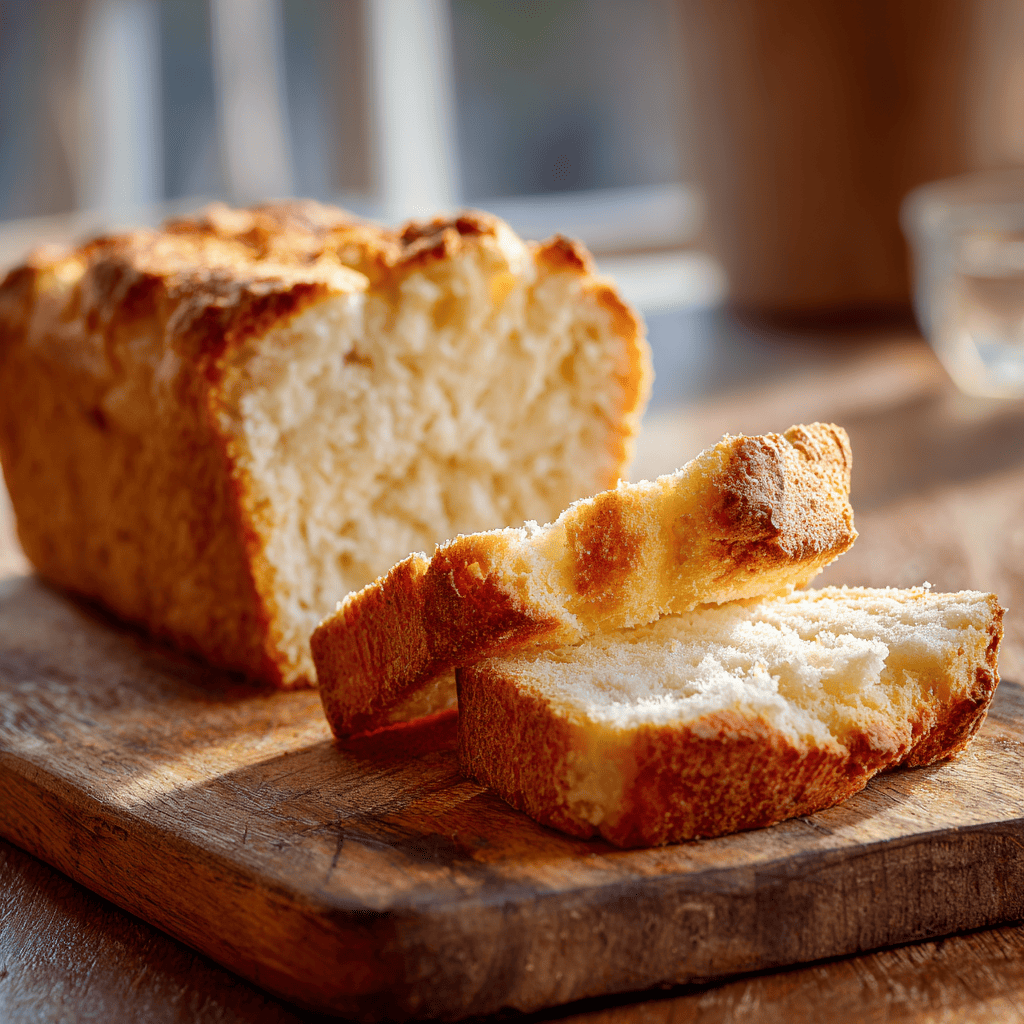
Table of Contents
Our Story With Keto Bread Recipe
How It Became Part of Our Kitchen
When we first tried making a keto bread recipe, it was far from perfect. Some loaves collapsed in the middle. Others had a strong egg flavor. Still, we kept trying. One evening in our Santa Fe kitchen, Mary pulled out almond flour, Andre preheated the oven, and our son Liam insisted on cracking the eggs. Of course, he dropped a shell or two, and our pup Coco was quick to grab the crumbs. It was messy, but that night we found a version of keto bread that actually worked. That moment turned this recipe into more than food. It became a part of our family rhythm.
Why We Love Making Keto Bread at Home
We love this keto bread recipe because it fits into real life. It bakes in under an hour, slices well, and tastes soft enough for sandwiches. On busy school mornings, we toast a slice, spread on butter, and feel good knowing it’s low carb but still filling. During weekends, we use it for French toast, letting Liam dip the slices into egg while Coco waits under the counter for spills. The joy is in the simplicity. Every time we bake it, we’re reminded that food doesn’t have to be complicated. It just has to bring people together, one slice at a time.
How to Make Keto Bread Recipe Step by Step
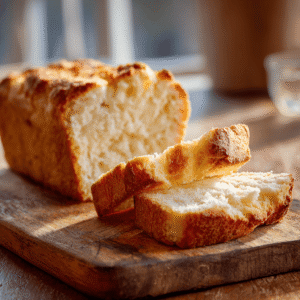
The Best Keto Bread Recipe
Ingredients
- 1 cup blanched almond flour
- 1/4 cup coconut flour
- 2 tsp baking powder
- 1/4 tsp sea salt
- 1/3 cup unsalted butter melted (or coconut oil for dairy-free)
- 12 large egg whites about 1 ½ cups, room temperature
- Optional: 1 tbsp monk fruit sweetener
- Optional: 1/4 tsp xanthan gum
- Optional: 1/4 tsp cream of tartar
Instructions
- Preheat oven to 325°F (163°C). Line an 8 ½ x 4 ½ inch loaf pan with parchment paper.
- Mix almond flour, coconut flour, baking powder, salt, sweetener, and xanthan gum in a food processor.
- Add melted butter and pulse until crumbly.
- In a large bowl, beat egg whites with cream of tartar until stiff peaks form.
- Fold half the egg whites into the flour mixture, then fold everything into remaining egg whites.
- Transfer batter to loaf pan, smooth the top.
- Bake 40 minutes, cover with foil, then bake 30–45 minutes more until golden. Internal temp should reach 200°F (93°C).
- Cool completely before slicing.
Notes
- Tip: Slicing only after cooling prevents the bread from collapsing.
- Storage: Keep in fridge for 7 days or freeze for up to 3 months.
Ingredients You’ll Need
Every keto bread recipe starts with a few essentials. Here’s a clear look at what goes into this loaf:
For the Base:
- 1 cup blanched almond flour (fine texture works best)
- 1/4 cup coconut flour (helps balance almond flour, reducing eggy taste)
- 2 teaspoons baking powder (use aluminum-free for better flaor)
- 1/4 teaspoon sea salt (balances sweetness and enhances flavor)
- 1/3 cup unsalted butter (solid, then melted; substitute coconut oil for dairy-free)
- 12 large egg whites (about 1 ½ cups, room temperature for best whipping results)
These six ingredients are the heart of a successful keto bread recipe. You can mix them with ease, and each has a role in keeping the loaf fluffy instead of heavy.
Optional Add-Ins (Recommended for Better Texture & Taste):
- 1 tablespoon monk fruit allulose blend (or any preferred low-carb sweetener, optional if you prefer savory bread)
- 1/4 teaspoon xanthan gum (improves elasticity, omit if you’re paleo)
- 1/4 teaspoon cream of tartar (helps egg whites whip faster and stay stable)
Easy Step-by-Step Process
Making this keto bread recipe is simple if you follow the right order.
- Prepare your oven and pan: Preheat the oven to 325°F (163°C). Line an 8 ½ x 4 ½ inch loaf pan with parchment paper, leaving some overhang for easy lifting later. This prevents sticking and helps remove the loaf cleanly.
- Mix the dry ingredients: In a food processor, combine almond flour, coconut flour, baking powder, sweetener (if using), xanthan gum, and salt. Pulse briefly until evenly mixed. This step distributes the leavening evenly so the bread rises properly.
- Add the fat: Pour in the melted butter or coconut oil. Pulse again until the mixture looks crumbly, scraping down the sides as needed. This coats the flours and creates a tender texture once baked.
- Whip the egg whites: In a large bowl, beat the egg whites with cream of tartar (if using) until stiff peaks form. The bowl should be roomy since the whites will expand a lot. Stiff peaks mean the whites stand tall without collapsing — this creates the fluffy lift in the bread.
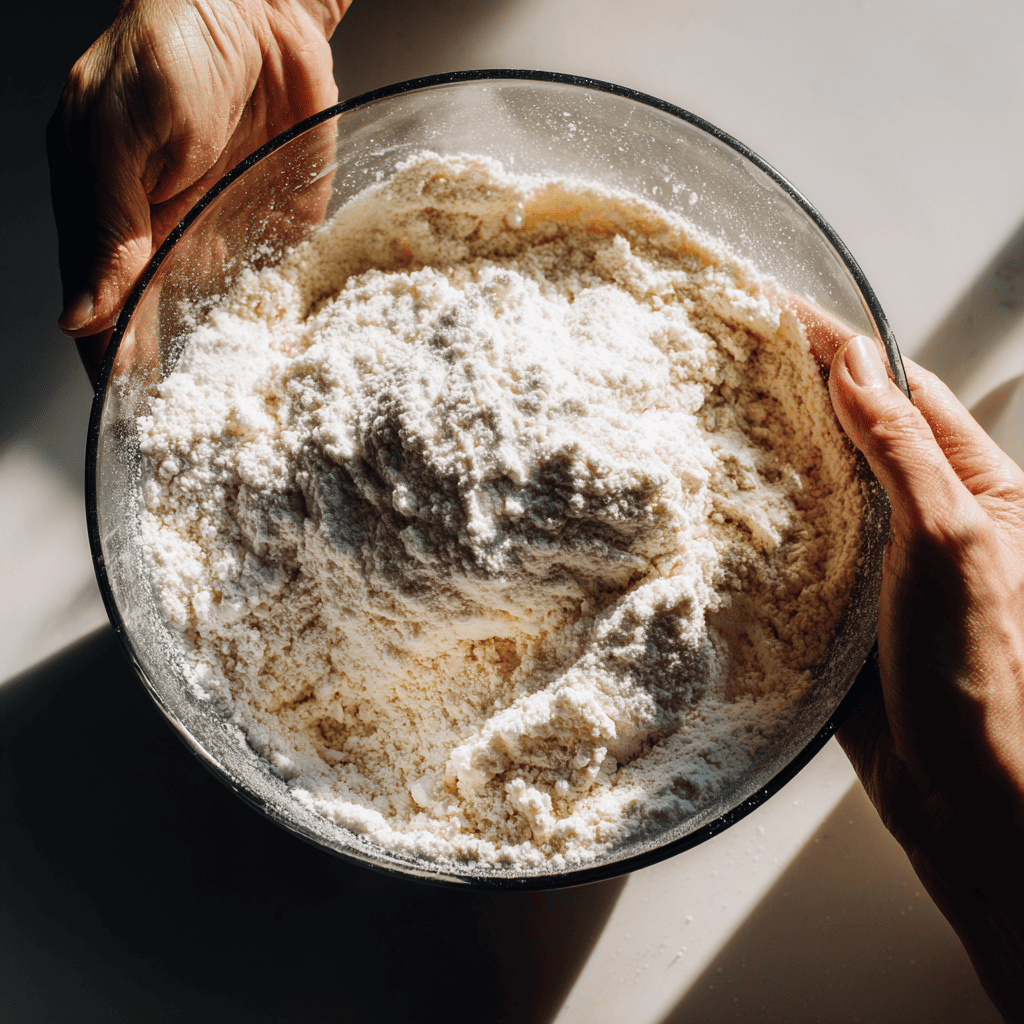
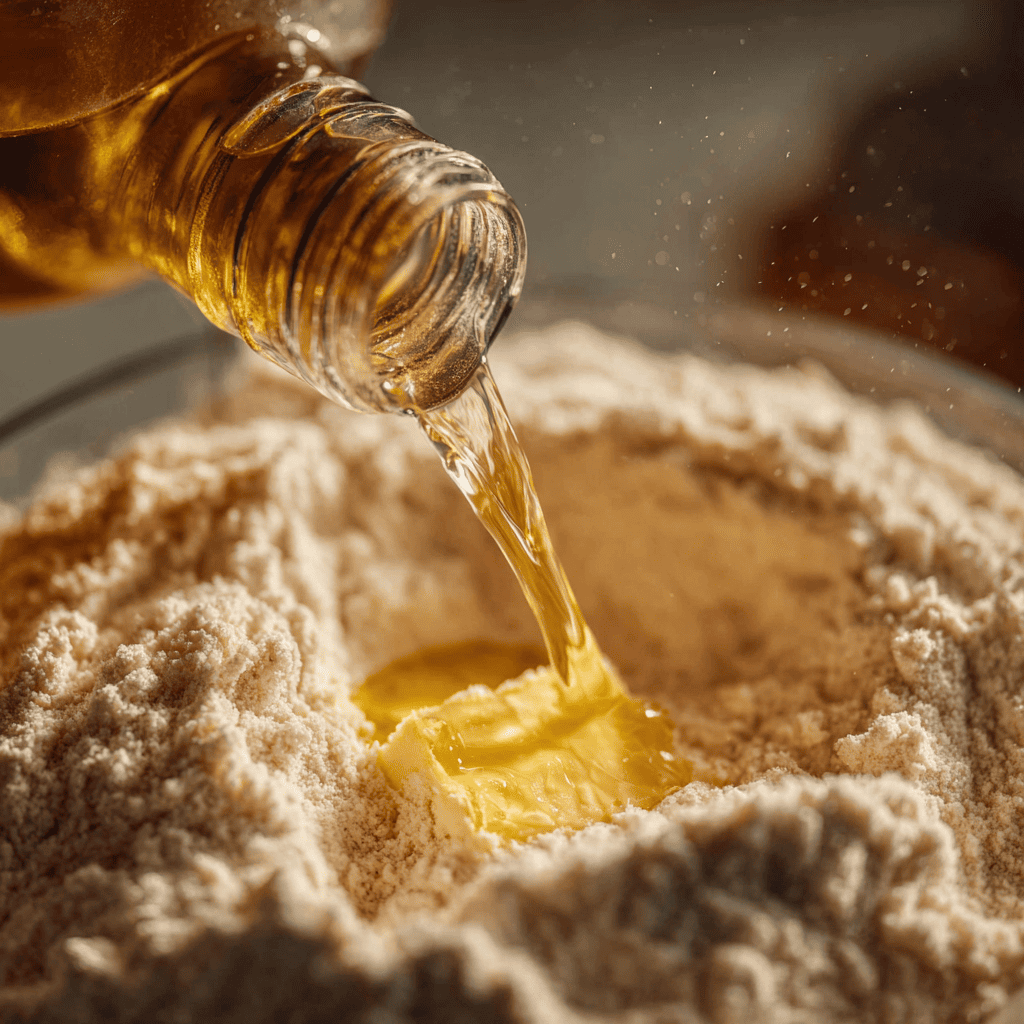
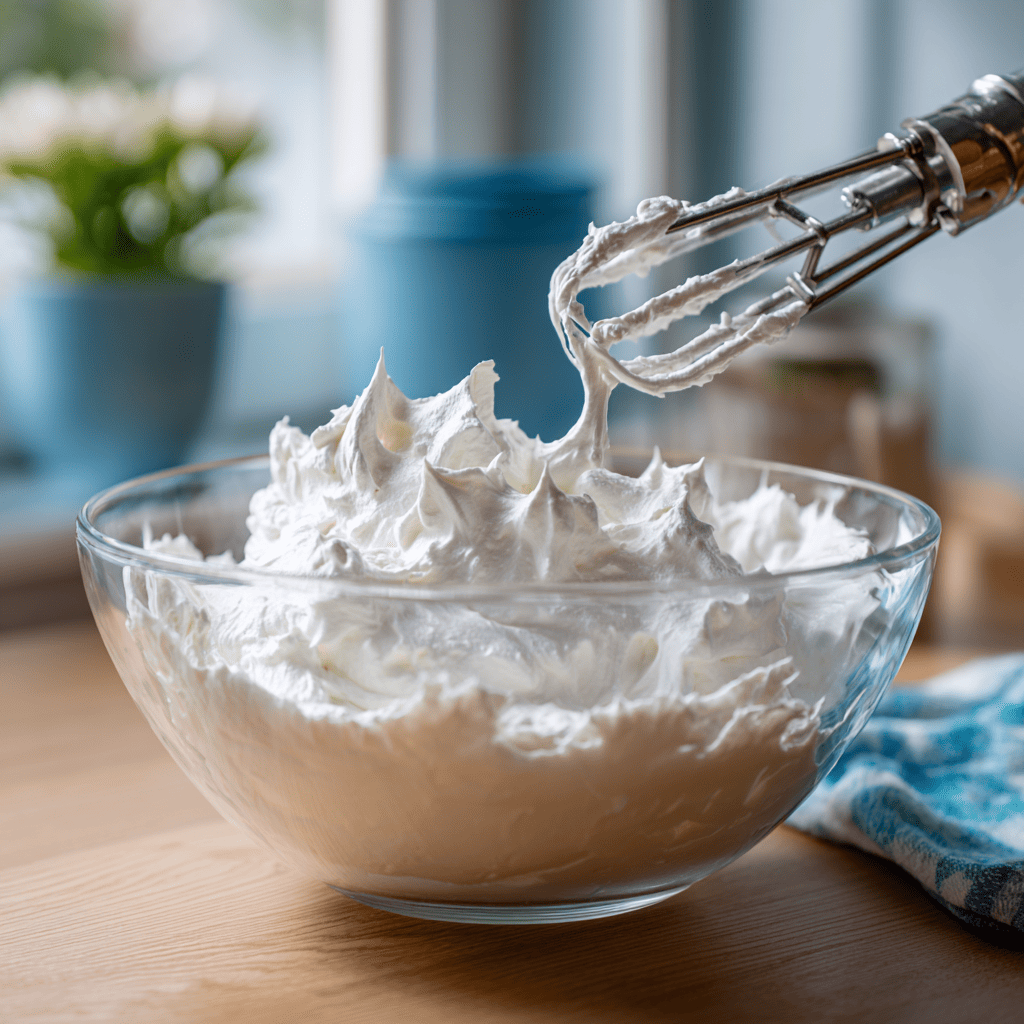
5. Combine the mixtures: Add half of the whipped egg whites to the food processor and pulse lightly until just combined. Don’t over-mix, as this will deflate the whites. Then gently fold this mixture into the remaining egg whites in the bowl. Use a spatula and fold slowly until no white streaks remain. Folding carefully keeps the batter airy.
6. Shape and bake: Transfer the batter to the prepared loaf pan. Smooth the top with a spatula and gently round it toward the center to help the loaf rise evenly. Bake for 40 minutes, until the top is golden.
7. Finish baking with a tent: Cover the loaf loosely with foil to prevent over-browning, then continue baking for another 30 to 45 minutes. The bread is ready when the top feels firm and the internal temperature reaches 200°F (93°C).
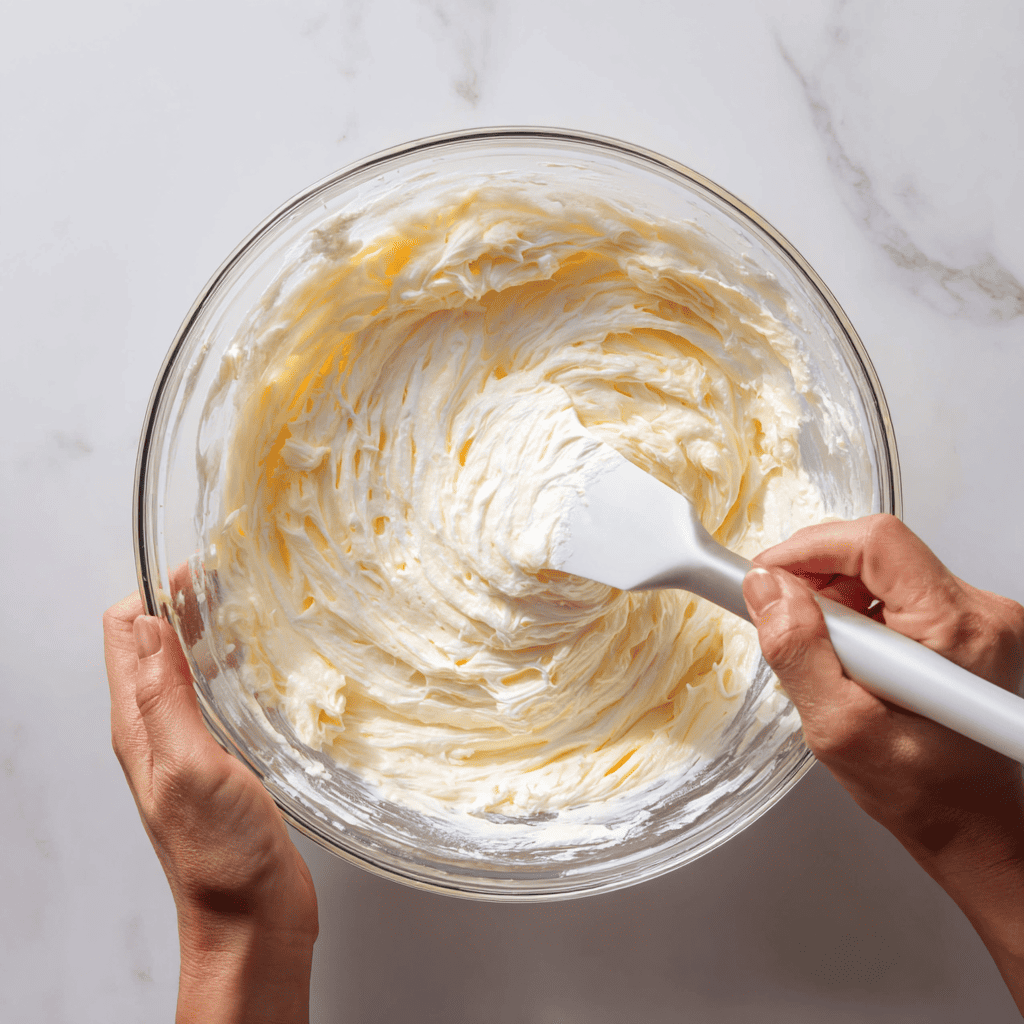

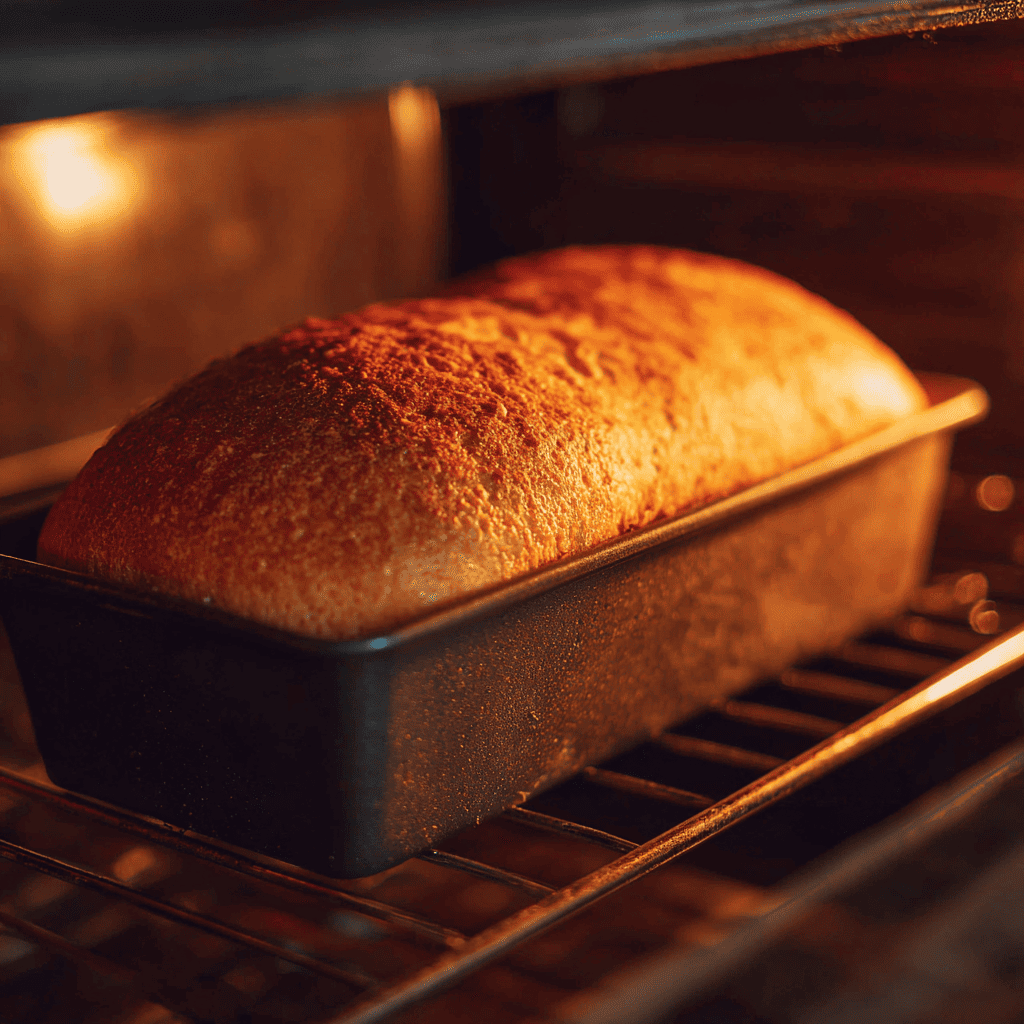
8. Cool completely: Let the loaf cool fully in the pan before slicing. Cooling sets the structure and ensures neat slices. Cutting too soon can cause the bread to collapse.
This process keeps the bread light while avoiding the common pitfalls of keto baking. If you’ve struggled with dense or eggy loaves before, this step-by-step method will give you consistent results.
Equipment Needed for This Recipe
You do not need any professional bakery equipment to make this keto bread recipe at home. In fact, you likely already have everything you need in your kitchen. Before you begin, gather the following tools to make the process smooth and efficient:
- An 8 ½ x 4 ½ inch (21×11 cm) loaf pan
- A food processor or a large mixing bowl with a hand mixer
- A separate large, clean bowl for whipping egg whites
- A spatula for folding and spreading the batter
- Parchment paper
Variations and Tips for the Best Keto Bread Recipe
Variations You Can Try
One of the best parts about this keto bread recipe is its flexibility. You can adjust it to match your dietary needs without losing texture or flavor. Here are some delicious variations to try:
- Nut-Free Keto Bread
- Swap almond flour with sunflower seed flour.
- The taste is slightly nutty and earthy, but the texture stays soft and fluffy.
- Great option for those with nut allergies who still want a satisfying low-carb loaf.
- Tip: Be aware that sunflower seed flour can sometimes turn green when baked due to a reaction with baking soda, but it’s harmless.
- Dairy-Free Keto Bread
- Replace butter with coconut oil or avocado oil.
- Coconut oil gives a mild, sweet flavor, while avocado oil keeps the bread more neutral.
- Both options make the bread completely dairy-free while maintaining a light crumb.
- Ideal for anyone following a paleo or dairy-free lifestyle.
- Coconut Flour-Only Keto Bread
- If you want to skip almond flour entirely, use coconut flour only.
- Since coconut flour absorbs much more liquid, reduce the amount to one-third of what’s listed and increase the eggs to provide structure.
- The result is a denser but still soft loaf with a slightly sweeter flavor.
- This variation is lower in calories and great for anyone who prefers coconut-based baking.
These simple swaps mean you don’t have to give up bread on keto, no matter your dietary restrictions. Whether you’re nut-free, dairy-free, or just experimenting, this keto bread recipe adapts to fit your lifestyle while staying low carb and satisfying.
Tips and Troubleshooting Common Issues
Even with a solid recipe, problems can happen. The good news is they’re easy to fix. If your keto bread recipe tastes too eggy, try using room-temperature eggs and add a splash of vinegar or lemon juice to the batter. This balances the flavor. If the center feels soggy, it usually means the loaf was underbaked. Cover the top with foil and bake an extra 10 minutes. For loaves that turn out dense, sift the almond flour before mixing and don’t overbeat the batter. Each of these tips improves texture and flavor, making your bread taste closer to classic wheat bread.
By using these variations and simple fixes, you’ll feel confident every time you bake. Instead of worrying about mistakes, you’ll have a dependable keto bread recipe that always delivers.
Storing, Serving, and Nutrition for Keto Bread Recipe
Storage and Freezing Tips
A good keto bread recipe stays fresh if you store it the right way. At room temperature, keep the loaf in an airtight container for up to three days. If you want it to last longer, move it to the fridge where it stays fresh for up to a week. For long-term storage, slice the loaf and freeze the pieces. This way you can pull out a slice whenever you need it. Toasting straight from the freezer works perfectly, giving you warm bread in minutes. Storing it this way also prevents waste, making sure every slice gets enjoyed.
How to Serve Keto Bread
This keto bread recipe is incredibly versatile. Here are some favorite ways to enjoy it:
- Sandwiches Made Simple
Slice the bread thin and pile on your favorite fillings. Turkey and cheese, chicken salad, or even a BLT all work perfectly. The bread is sturdy enough to hold layers but still soft to bite into. - Classic Toast
Toast slices until golden, then spread with butter, nut butter, or cream cheese. Add toppings like avocado or smoked salmon for a quick but satisfying meal. - Weekend French Toast
Dip slices into beaten eggs with a splash of cinnamon, then fry until golden. Top with sugar-free syrup or fresh berries for a keto-friendly brunch treat. - Soup and Salad Companion
Serve it warm on the side of a bowl of soup or a fresh salad. Its mild flavor balances well with hearty stews or light greens. - Snack-Ready Bites
Cut the bread into cubes, toast them in the oven, and you have homemade keto croutons. These add crunch to salads or can be enjoyed as a quick bite. - Creative Meal Prep
Freeze slices in portions and reheat them as needed. This makes busy mornings easier and keeps your keto bread recipe always on hand.

While this bread is perfect for sandwiches and toast, it also makes an excellent side for a savory, protein-rich meal. We especially love pairing a warm slice with a hearty main course that’s both easy to make and satisfying. For a perfect brunch or a light dinner, try serving this bread alongside our Cottage Cheese and Spinach Crustless Quiche. The rich flavors of the quiche and the soft texture of the bread create a truly delicious and completely guilt-free meal.
Nutrition at a Glance
Here’s a quick breakdown per slice (based on 12 servings):
| Nutrient | Amount | Notes |
|---|---|---|
| Calories | 150 kcal | Provides steady energy without spiking carbs. |
| Net Carbohydrates | 2 g | Keto-friendly, keeps you in low-carb range. |
| Total Carbohydrates | 3 g | Mostly from almond flour and coconut flour. |
| Dietary Fiber | 1 g | Supports digestion and balances net carbs. |
| Protein | 6 g | From egg whites and almond flour, helps with satiety. |
| Total Fat | 13 g | Healthy fats from butter or coconut oil. |
| Saturated Fat | 5 g | Mainly from butter or coconut oil. |
| Unsaturated Fat | 7 g | Heart-healthy fats from almond flour and oils. |
| Trans Fat | 0 g | None, since recipe avoids processed fats. |
| Cholesterol | 0 mg | Uses egg whites only, making it lower in cholesterol. |
| Sodium | 200 mg | Comes mainly from sea salt and baking powder. |
| Sugar | 1 g | Naturally present in almond and coconut flour, no added sugar. |
Each slice of this keto bread recipe has 150 calories, 2g net carbs, 6g protein, and 13g healthy fats — the perfect balance for low-carb living.
Your Turn! Did You Make This Recipe?
This keto bread recipe proves that low-carb baking doesn’t have to be complicated. With just a few ingredients, clear steps, and some family-tested tips, you’ll have a loaf that’s soft, fluffy, and versatile. It works for sandwiches, toast, or even French toast, and it fits into busy schedules with ease. From storage tricks to flavor variations, this recipe adapts to your lifestyle while staying true to keto goals. If you’ve struggled with dense or eggy bread before, give this version a try. It’s the one that finally worked for our family, and we think it’ll become a favorite in your kitchen too.
If you try this keto bread recipe, let us know how it turned out by leaving a comment and a star rating. Your feedback helps others and inspires us to keep sharing recipes that work in real life.
We’d also love it if you shared this recipe on Instagram and Facebook so more people can enjoy it. Did you try a nut-free version, a dairy-free swap, or stick to the classic loaf? Share your variation below, we can’t wait to see how you make it your own!
Frequently Asked Questions
What is the best flour for keto bread?
The best flour for a keto bread recipe is almond flour. It gives the bread structure while keeping carbs low. Some people add a small amount of coconut flour for balance, which helps reduce the eggy flavor and creates a lighter texture.
Is Aldi’s keto bread really keto?
Aldi’s keto bread is labeled as “zero net carbs” because it contains a lot of fiber. While it is low in net carbs, it’s not grain-free like homemade keto bread. If you want total control over ingredients, making your own keto bread recipe at home is the best choice.
What are common mistakes when making keto bread?
You can avoid the most common mistakes by focusing on three key details. First, you must gently fold in your whipped egg whites, as over-mixing will make your loaf dense. Additionally, you should bake the bread until a thermometer reads 200°F (93°C) to prevent a soggy center. Finally, you must let the loaf cool completely before slicing so its delicate structure can fully set
What are the ingredients of keto bread?
Keto bread recipes use a core set of ingredients to replace wheat. They start with a base of low-carb flours, like almond and coconut flour. To create a bread-like structure, they then rely on binders such as eggs, psyllium husk, or xanthan gum. Finally, these recipes include healthy fats like butter for moisture and a leavening agent like baking powder to help the loaf rise.